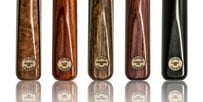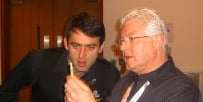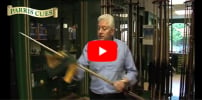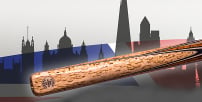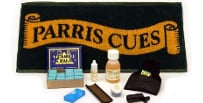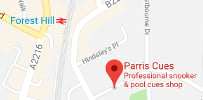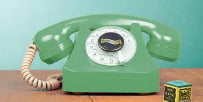This website is using cookies.We use cookies to ensure that we give you the best experience on our website.
Faq
Why choose a Parris Cue?
I think Parris cues are the best in the world. But then again I would say that. There are reasons though for this statement.
From the very start I spend many hours relentlessly selecting the best straight grained ash and maple for our shafts, From timber yards with vast stocks I only select around 5% of the timber I inspect and from this around 50% is rejected during manufacturing giving a tiny 2.5% yield making our shafts as perfect as possible, They are selected for straight grain, clean wood, density, rigidity, grain spacing and above all my personal test of feel, This is something that cannot be measured but that I have developed in over 25 years of experience. The shafts are tapered in gradual stages being left for long periods between each stage for the wood to settle.
The butts are meticulously hand spliced with various exotic woods, most of which I have personally selected.
Joints are precision fitted and machined to ensure perfect alignment and contact.
Where ever possible the shaft and other materials are selected to give the cue a natural weight and balance without the use of additional lead.
They are then painstakingly finished by hand giving a silky smooth feel.
No trouble is too great to ensure what I think is the perfect cue.
This view is also held by many professional and top amateur players that depend on Parris Cues, see References and Gallery.
What am I paying for when buying a Parris Cues?
Does John Parris pesonally work on the cues anymore
Yes I do. I personally select most of the exotic timber and all of the Ash and Maple we use from specialist suppliers. Spending many sometimes back breaking but rewarding hours choosing woods for their grain pattern and quality. In the workshop I carry out what I consider the most important tasks I do some of the work on all of the cues with all other work being done under my close supervision. Nothing happens without my approval. The craftsmen I employ have many years experience in their own skills such as Joinery, Engineering and French Polishing. Some have been with me for up to twenty years. I have taken those skills and applied them to making cues my way. I check the cues at every stage of their creation to make sure everything is perfect. No cues leave the workshop without my final test and inspection.
Are any Parris cues made or partly made by anyone else for you?
What is the difference between ash and maple cues?
Ash is by far the most popular wood for snooker and English pool cues. Maple is traditionally the only wood used for American pool cues but there is no real reason ash could not be used.
Maple is denser than ash and does not have the pronounced grain features of ash. The enhanced grain of ash cues is highly regarded by many players, but can be distracting for those who prefer maple. I personally think ash has a better feel then maple. The natural spring giving more response. This said there are some very good players using maple cues.
They are both good timbers and it is a personal choice.
What length should my cue be?
The main factors that influence cue length are, length of arms, stance, a straight or bent bridge arm and preferred amount of cue past your bridge when cueing. To check, hold the cue with 1” (2.5cm) of butt protruding past your little finger, take up your normal hand on the table cueing stance as if you were about to play a shot, making sure the forearm (hand to elbow) of your cueing arm is vertical (90 deg to floor). Ideally, in this position you should have 12” (30.5cm) of cue past the vee of your bridge hand. This will ensure you have enough length for a full cue action, with a spare 1” (2.5cm) past your cueing hand to use for power and deep screw shots.
The 12” (30.5cm) measurement can be varied for players that prefer a particularly long or short bridge, but in general this is a good guide.
What length cue for a younger player
For younger players, not fully grown we suggest a slightly shorter cue. A butt jointed cue with a shorter than standard butt that can be extended or changed to a full length butt as the player grows is a good idea. This means the cue can grow with the player and keeps the characteristics of the cue they are used to rather than change to a completely new cue. The standard measurement of 12” (30.5mm) of cue past your bridge suggested for adult players needs to be extended slightly depending on the height of the player to allow for some growth and also the fact that a lot of shots will be out of reach for a shorter person and they can slide the cue forward to save constantly using the rest or extension.
A video guide to measuring the Ideal Cue Length for you is also available
What weight cue should I choose?
Cue weight is dependent on the individual players preference. The cue should be heavy enough to play shots without having to put too much effort into it which invariably means you will move on the shot and loose accuracy but not so heavy that you cannot play delicate touch shots, but every player is different.
I recommend a weight between 18oz to 20oz (509g to 565g) for snooker. 17oz to 19.oz (482g to 538g) for English pool and 18.5oz to 21oz (524g to 595g) for American pool.
Wherever possible cue shafts are selected to have a natural weight as close to the required cue weight as possible. This means the minimum or no additional weight need be added to the cue giving it a better natural balance.
What is the best tip size?
Most snooker players prefer a tip size between 9mm to 10mm with 9.5mm being the most popular.
English pool players tend to use a smaller tip between 7mm to 9.5mm mainly due to smaller lighter cue ball.
American pool is between 11mm to 13mm.
There are many theories about tip size regarding the amount of spin you can impart on the cue ball with a smaller tip and how it is easier to hit the centre of the ball with a bigger tip.
It is really down to personal preference.
The amount of spin is mainly down to cue action, timing and most important a good follow through with the cue after striking the white ball.
The ability to hit the centre of the white consistently is down to your cue action, a firm bridge, good stance and keeping still on the shot.
Tip size does have an effect on the amount of throw caused by the cue on to the cue ball when using side. The amount of throw is proportional to the size of the tip i.e. the bigger the tip the more the cue ball is pushed off line, this amount does vary from cue to cue. No two cues react exactly the same with regard to throw off. All cues do it some more than others, it is mainly a case of getting used to your own cue and making the correct adjustments when taking aim.
What is the difference between tip brands?
There are two main brands of tip used by snooker and English pool players. They are Tweeton Elk Master and Brunswick Blue Diamond. They are both similar tips the blue diamond is slightly taller than the elk master but apart from that I think they are the same. You get a range of densities in both, from so spongy they cannot be used up to rock hard. Again there is no ideal it is personal preference and experience to how hard you like a tip. I think a medium hard tip with just enough give to grip the cue ball is best.
American pool players mainly use Le Pro tips.
Recently there have been a number of laminated cue tips coming on the market they are much more consistent and are available in soft ,medium and hard densities. I think the jury is still out on how good these tips are. When they are used snooker and English pool players seem to prefer the talisman and Kamui black tips. American pool players the Mouri and Kamui tips, but there are many other brands of laminated tip.
What is the best butt diameter?
The butt diameter is the measurement across the very end of the butt from side to side NOT around the outside. The most popular butt diameter is 30mm this suits most players and is the standard size we make the Parris Collection cues.
As a guide
27mm is very slim
28mm to 28.5mm is slim
29mm to 30mm is medium
31mm is thick
32mm is very thick
Should I have a 1pc or jointed cue?
What type of joints do you use and why?
For Snooker and English Pool cues
The joints in the cues are precision made from a single piece of solid brass. A 3/8” male and female thread joins the cue with an interlocking face that continues to the outside edge of the cue. I chose to use a normal thread because I think it is stronger and more reliable than a quick release joint.
The standard male and female thread of our joint is easier to keep clean than the inside out so called airlock type joint (used by most far eastern cue makers) they do not actually use any air to lock them together but merely make a noise when they are pulled apart. With the brass to brass faces of our joints locked together they give a very solid positive feel. The brass faces on the joint also have two other functions. One is to protect and reinforce the outside edge of the cue, a wooden edge would chip and wear very easily. The second is to glue the back of the brass face to the end grain of the cue this strengthens the end grain and stops it splitting open if the cue is knocked or dropped.
The SD joints are a brass quick release joints with our own special thread. I will not use quick release joints to join the cues themselves but I think it is ok for the extensions where you only play one shot and then unscrew them, with speed being an important factor.
For American pool cues
The joints are brass 5/16” 18 TPI male and female threads. The male joint is electro-polished for a bright finish. The wood to wood faces of the joint are protected with outside collars made of black thermo-set double linen phenolic impregnated plastic.
What is an SD joint?
What is Hand Splicing?
What type of finish should I have on my cue?
I think the best finish is Raw Linseed Oil. This protects the cue from moisture in damp or humid conditions and also stops it from drying out in hot and dry conditions. It gives the cue a smooth finish that does not drag on your bridge when cueing and also enhances the natural beauty of the wood.
The butt should have a hard wax burnish that gives it a natural smooth feel and a silky shine. The shafts should not be waxed as this will make the cue drag on your bridge hand when cueing
All Parris cues are oil finished with a wax burnish on the butt. Oil finished cues should be re oiled on a regular basis. See our cue care section for details also the Accessories section for Cue Oil and Wax.
What are the delivery times for cues and cases?
We do have cues in our shop for customers visiting us to test on our shop table and buy on the day. With website or Telephone order cues I do not select these from the shop they are all made to order, otherwise this would deplete our shop stock too much, I can also insure you get exactly what you want rather than trying to find something in stock that is close to your requirements. We do not select cues from the shop for mail order in any circumstances.
The delivery times for cues vary depending on model and style. In general 3/4 cues are quicker than 1pc.
Approximate Delivery Times
Parris Collection Cues 12-18 Months for 16” 3/4 cues and 18-22 months for 1pc, 2pc and 12” joint butt cues
American Pool Cues 18-24 Months
Limited Edition Cues 18-24 Months
Special Cues 10-14 Months for 16” 3/4 cues and 28-32 months for 1pc, 2pc and 12” butt joint cues
Paragon Cues 10-14 Months for 16” 3/4 cues and 28-35 months for 1pc, 2pc and 12” butt joint cues
Ultimate Cues 24-36 months for 16” 3/4 cues and 75-85 months for 1pc, 2pc and 12” butt joint cues
Leather Cases 6 months depending on design and workload
Clothing and Accessories 1-3 weeks
Delivery times do depend on the availability of the correct shaft for your cue. The shaft has to have the correct weight, balance, rigidity, feel and of course the right look. All shafts are individually selected for each cue by John. We have shafts constantly in various stages of production with a new batch being finished every 2-3 weeks. Shafts take from 6 to 12 months to produce depending on the model, it is important they are made slowly to ensure stability.
Although every effort will be made to complete your cue as soon as possible, delivery times quoted are approximate and can with some cues take considerably longer. If we are taking longer it is only because we are perfectionists and trying to find the ideal shaft to make your perfect cue. Demand for our cues has increased considerably over the last few years which has caused an increase in delivery times for cues.
Parris Cues cannot be held liable for cues taking longer than the approximate times above.
How do you send my cue?
All cues or cues/cases are securely packaged.
They are sent by courier and are fully insured in transit at no risk to the customer.
All items must be signed for at time of delivery.
All items must be checked for damage at time of delivery and signed for as damaged if not in perfect condition.
UK mainland deliveries are sent on a next day service.
UK highlands and islands are normally a two day service.
Overseas deliveries are by UPS air courier and normally take between two and five days.
Accessories are sent by First Class post or Air Mail depending on destination. Delivery times may vary depending on local post.
What if I cannot get on with my new cue?
We are totally committed to happy customers.
Is my cue straight, and how do I check it?
How do I maintain my cue?
How do I re tip my cue?
A video guide to Re Tipping your Cue is also available
See Cue Accessories to purchase Tips and Re Tipping equipment.
How do I clean and maintain my cue joint
To keep the joint clean, using a small pad of fine grade (00-00) wire wool carefully clean the faces and thread of the joint with a circular twisting motion taking care not to touch the wood of the butt with the wire wool, as it will mark the polished surface of the butt.
Metal cue joints can sometimes make an annoying squeaking noise when screwing or unscrewing the cue. If this happens clean the cue as above and apply a tiny amount (a pin head size) of Parris Joint Glide to the end of the male thread of the joint then screw the cue together. This will lubricate the joint and make it silent. Care must be taken not to get any Joint glide on the flat faces of the joint, this needs to be kept clean and dry, only a tiny amount is needed.
See Cue Accessories to purchase Parris Joint Glide
How do I keep the sheen on the butt of my cue
Apply Cue Polish to the Butt of your cue sparingly, allow to dry for approximately 10 minutes and then buff with a soft cloth until desired sheen is obtained. Only apply Cue Polish to the butt of your cue, not the shaft. Use Parris Cue Oil to protect the cue shaft.
See Cue Accessories to purchase Parris Cue Polish & Parris Cue Oil
What is 3D Secure? - Verify by Visa™ & MasterCard SecureCode™
During the Payment Process the page requesting your 3D Secure password is supplied by your bank, customers already enrolled in the scheme should enter their password when prompted, customers that have not previously enrolled may be presented with the opportunity to register and then continue with the transaction, this is dependent on your bank. If not please contact your bank directly to register.
Parris Cues requires Verify by Visa™ or MasterCard SecureCode™ authorisation for all Online Credit and Debit Card transactions. Alternatively you can opt to pay via Bank Transfer during the Checkout process.
How do I Register/Enrol for Verify by Visa™ & MasterCard SecureCode™?
If you are not presented with the registration page during the payment process please contact your bank directly to register.
Parris Cues requires Verify by Visa™ or MasterCard SecureCode™ authorisation for all Online Credit and Debit Card transactions. Alternatively you can opt to pay via Bank Transfer during the Checkout process.
What if my bank’s 3D Secure page doesn’t load?
What if I forget my 3D Secure password?
If not you will need to telephone you bank to have your 3D Secure password reset.
Do I pay any Tax on my cue
Any cues being sent by us to a destination outside of the European Union countries will be Tax free but will be liable to any local tax or import duty charges when they arrive at there destination.
Please note Parris Cues cannot be liable for any of these charges and it is the customers responsibility to check what these charges may be.
Cues purchased and collected from our London Shop that are being taken outside of the EU by a non EU resident are subject to UK VAT tax but a tax reclaim form can be supplied with these cues.
What difference does a Titanium Ferrule make?
Titanium is much lighter, and higher density metal than a traditional Brass ferrule, the key benefit of this is the reduction in the deflection of the cue ball, when using side-spin.
We have previously experimented with other lightweight materials for ferrules.
In conjunction with Steve Davis we fitted a fibre ferrule to his cue. Steve used this cue in tournaments for 6 months, and although he was pleased with the reduced deflection, he was not as happy with the way the fibre ferrule affected some other cue reactions.
Our research has shown that Titanium ferrules do not change the other playing characteristics of the cue, to the same extent as fibre ferrules, although there are still some changes to the cue reaction (other than the beneficial reduced deflection) that can be addressed by adjustments to playing style and getting used to the way the cue ball reacts.
The sensitivity to these changes in cue reaction vary from player to player, and are lessened when switching to a new cue with a Titanium ferrule, as the player will already be adjusting to suit the characteristics of a new cue.
Parris Cues Titanium ferrules have been developed over a number of years, they are made from exceptionally high quality, European produced Titanium that is then additionally hardened in the UK using a method specially developed for Formula One racing cars.
Produced to our unique specifications by our UK partner, who has many years experience in manufacturing specialist Titanium products for very high profile industries including, Formula One racing, Petrochemicals and Pharmaceuticals.
Since late 2016 we have worked through a rigorous testing regime with a number of players, at all skill levels, gathering feedback on numerous experimental versions of Titanium ferrules, and now have the Ultimate Titanium ferrule, that meets the highest standards, that customers expect from Parris Cues
The Parris Cues Ultimate Titanium Ferrules are now available as an option on all new Parris Cues.

